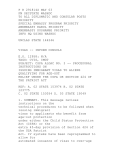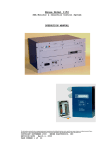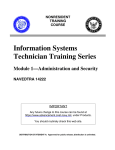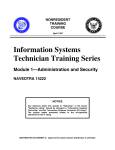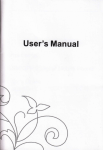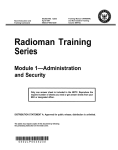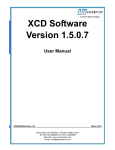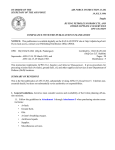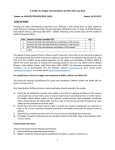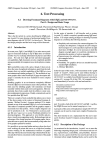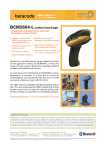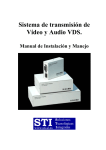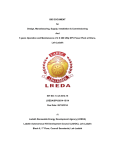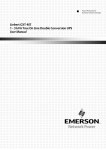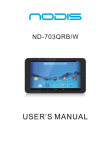Download 5 FAH-1 H-240 Telegrams - Preparing Telegrams at Post
Transcript
U.S. Department of State Foreign Affairs Handbook Volume 5 Handbook 1 Correspondence Handbook
5 FAH-1 H-240
PREPARING TELEGRAMS AT POST
(CT:CH-21; 11-23-2007)
(Office of Origin: IRM/BPC/PRG)
5 FAH-1 H-241 GENERAL
(TL:CH-09; 07-12-2004)
(Uniform all agencies)
a. At posts abroad, most users draft and send telegrams electronically from
their workstation. Although some posts can still send telegrams scanned
from an Optical Character Reader (OCR), this method seldom is used at
most posts.
b. Telegrams, prepared on a workstation, may be sent:
(1)
Through the Common LAN Outbound Telegram (CLOUT) system on
the unclassified network;
(2)
Through CableXpress (CX) on the classified network;
(3)
Via floppy diskette brought to the information programs center
(IPC), especially for highly sensitive telegrams; or
(4)
Via printout brought to the IPC. For such cables, page formatting
must be set as follows:
•
•
•
•
•
Print the telegram on plain white letter-size paper
Use Courier or Courier New, 12 point (10-pitch)
Set the margins to 1.25" left and right and 1" top and bottom,
usually the default for Microsoft Word documents
You must print the classification at the top and bottom of each
sheet (header and footer)
Signature block must not enter the text area that the OCR will
scan
c. Direct your questions, comments, or problems concerning telegrams to
your post's IPC.
5 FAH-1 H-242 CABLEXPRESS
5 FAH-1 H-240 Page 1 of 19
U.S. Department of State Foreign Affairs Handbook Volume 5 Handbook 1 Correspondence Handbook
(TL:CH-09; 07-12-2004)
(Uniform all agencies)
a. CableXpress (CX) is a telegram processing and handling application that
resides on the ClassNet network. You receive copies of incoming
telegrams in your personal inbox. You can store them in your local
archive, or you can call back old messages from the central archive.
b. You may prepare and send telegrams using CX. You can create telegram
templates for frequently used addressee patterns and store them in CX.
Then, when you need to send a telegram, you use the correct template
and just fill in the text.
c. You must still obtain all required clearances for outgoing telegrams.
However, you may send the draft telegram by e-mail to the clearance
officers through CX.
d. Please refer to IRM’s CX User Manual for detailed instructions and
guidelines. Most posts install an icon on the CX work page with a link to
the user manual.
5 FAH-1 H-243 COMMON LAN OUTBOUND
TELEGRAM (CLOUT)
(CT:CH-21; 11-23-2007)
(Uniform all agencies)
a. Use the Common LAN Outbound Telegram (CLOUT) application to send
outgoing telegrams as an e-mail attachment. Information Programs
Center (IPC) or the Information Systems Center (ISC) can inform you
which addressee listing to use in the Global Address List of the OpenNet
Plus or ClassNet network.
b. Use Microsoft Word to draft a CLOUT message. You must save the
message in MS Word format or as an ASCII text file (e.g., MS-DOS text
with line breaks.)
c. When creating a telegram you may use the MS Word macro, available
from your systems manager, to create the telegram. You may also draft
the telegram from a blank document following the pseudo-header format
outlined in 5 FAH-1 H-245.
d. Cables sent by CLOUT that contain hyperlinks can have problems due to
the number of characters in the hyperlink. Hyperlinks longer than 55
contiguous characters can be shortened using the Foreign Service
5 FAH-1 H-240 Page 2 of 19
U.S. Department of State Foreign Affairs Handbook Volume 5 Handbook 1 Correspondence Handbook
Institute’s URL Shrinker.
e. Do not send classified or NOFORN cables via unclassified CLOUT.
Classified cables must be sent via classified CLOUT with the appropriate
declassification markings.
f. Always notify IPC in advance when you want to send the types of
telegrams listed below via CLOUT. IPC has to immediately confirm
successful transmission of these types of messages:
(1)
FLASH telegrams; and
(2)
NIACT IMMEDIATE telegrams.
5 FAH-1 H-244 HOW TO PREPARE
TELEGRAMS ON DISKETTE
(TL:CH-09; 07-12-2004)
(Uniform all agencies)
a. If you need IPC to send a telegram for you, you may give it to IPC on a
floppy diskette. The telegram format must follow the pseudo-header
format for CLOUT transmission. That means there should not be a
signature block in the margin.
b. Use only 3.5" floppy diskettes:
(1)
Use formatted diskettes or format them before the message is
stored;
(2)
Confirm that each diskette contains only outgoing messages that
you want IPC to send; and
(3)
If you are sending more than one telegram, list the names of the
files either on the diskette label or on a separate sheet of paper.
This confirms you know there are two or more files (telegrams) and
that you want to send all of them.
c. Obtain all clearances and approvals before giving the diskette to IPC.
d. The diskette will be inserted in the TERP V terminal and from that time on
will be considered classified. It will not be returned to an unclassified
originating office.
5 FAH-1 H-240 Page 3 of 19
U.S. Department of State Foreign Affairs Handbook Volume 5 Handbook 1 Correspondence Handbook
5 FAH-1 H-245 HOW TO FORMAT OUTGOING
TELEGRAMS
(TL:CH-09; 07-12-2004)
(Uniform all agencies)
a. You must follow the pseudo-header format instructions listed in this
section, when drafting an outgoing telegram for CLOUT, diskette, or print.
The pseudo-header must have six lines. A seventh line is used to request
an acknowledgement, using the operating signal, ZFF. See 5 FAH-2 H228 for more information on the ZFF operating signal.
b. CableXpress will format an outgoing telegram automatically after your
initial configuration (usually done by the systems administrator). See the
CableXpress user manual—located in the CableXpress application—for
instructions on how to create an outgoing telegram.
c. Outgoing telegrams are created on CableXpress by filling in the fields in
the "New Cable" template and do not follow the pseudo-header format
instructions listed in this subchapter. However, information entered in
CableXpress fields follows the guidelines listed for the matching pseudoheader line.
5 FAH-1 H-245.1 Pseudo-Header Line 1: How To
Mark the Classification
(CT:CH-13; 08-15-2006)
(Uniform all agencies)
a. The classification line is the starting point for the scanner or OCR. All
other entries must align with the classification line. Enter the
classification of the telegram in full capitals. Spell out the classification,
except for Unclassified Encrypt for Transmission Only (which should be
entered as UNCLAS EFTO). For example: SECRET, CONFIDENTIAL,
UNCLASSIFIED.
b. For Sensitive But Unclassified, enter UNCLASSIFIED on this line; add
SENSITIVE on the caption line as instructed in 5 FAH-1 H-245.11.
c. See 5 FAH-1 Exhibit H-245.1 for an example of a pseudo-header format.
5 FAH-1 H-245.2 Pseudo-Header Line 2: How To
Enter the Charge Symbol and Date
5 FAH-1 H-240 Page 4 of 19
U.S. Department of State Foreign Affairs Handbook Volume 5 Handbook 1 Correspondence Handbook
(TL:CH-09; 07-12-2004)
(Uniform all agencies)
a. IPC and the post's management use the charge symbol for tallying
telegraphic workloads. The charge symbol is usually in the form of the
drafting agency's name. You can get a current list of all charge symbols
used at post. Enter the charge symbol in full capitals on this line.
b. Two spaces after the charge symbol enter the drafting date of the
telegram. Use the form mm/dd/yyyy. TERP uses this date on the
outgoing telegraphic format as the date-time-group.
5 FAH-1 H-245.3 Pseudo-Header Line 3: How To
List the Approving Officer
(TL:CH-09; 07-12-2004)
(Uniform all agencies)
The approving officer is the person who authorizes the release of the
telegram for transmission. Enter the complete office symbol, followed by a
colon, the first and middle initials, and the last name of the approving
officer. (If the approving officer has no middle initial, enter the first initial
and last name.)
5 FAH-1 H-245.4 Pseudo-Header Line 4: How To
List Drafting Officer
(CT:CH-13; 08-15-2006)
(Uniform all agencies)
On this line, enter your complete office symbol followed by a colon, your first
and middle initials, and your last name. (If you have no middle initial, enter
your first initial and last name.) If the preparer is someone other than the
drafter, that person's initials should follow your name preceded by another
colon. See 5 FAH-1 Exhibit H-245.1 for an example of a pseudo-header
format.
5 FAH-1 H-245.5 Pseudo-Header Line 5: How To
List Clearances
(TL:CH-09; 07-12-2004)
(Uniform all agencies)
a. To list a clearing officer, enter the agency and/or office symbol followed
5 FAH-1 H-240 Page 5 of 19
U.S. Department of State Foreign Affairs Handbook Volume 5 Handbook 1 Correspondence Handbook
by a colon, first and middle initials, and last name of the clearing officer.
(If the clearing office has no middle initial, enter the first initial and last
name.) If there is more than one clearing officer, list them horizontally
separated by a comma and space.
b. You must use only line five of the pseudo-header for clearing officers. If
you have more than will fit on this one line, consider shortening the
names by using only initials, or use your post's procedures.
c. If you do not require anyone to clear your telegram, enter the word
"NONE" on this line. You must not leave this line blank or skip it (i.e., by
entering the distribution on line 5 of the pseudo header).
5 FAH-1 H-245.6 Pseudo-Header Line 6: How To
Apply the Desired Distribution
(TL:CH-09; 07-12-2004)
(Uniform all agencies)
a. TERP V uses dissemination symbols to specify a predetermined
distribution pattern. This line is mandatory. The first entry on this line
must be the dissemination symbol that provides the distribution pattern
you want. IPC can provide you a list of all the dissemination symbols in
use at your post. They usually differ from post to post.
b. In addition to dissemination symbols, TERP V uses office symbols to
further define distribution. You may add to the distribution pattern by
listing an office symbol(s) after the dissemination symbol. List office
symbols on the same line separated by a space. IPC can provide you
with a list of all the office symbols in use at your post.
c. If there is no dissemination symbol that matches your desired distribution
pattern, you may request IPC create one, if you will use it more than
once. Otherwise, you may enter the word "NONE" followed by the office
symbols of your desired distribution. For example: NONE MGT RSO HR
(the last three acronyms are office symbols).
d. Take special note of the dissemination symbols designed specifically for
certain distribution channels, such as EXDIS, NODIS, STADIS, ROGER
CHANNEL, etc. If you use the wrong dissemination symbol on these
types of telegram, they could be distributed to the wrong offices and
could result in security incidents.
5 FAH-1 H-245.7 How To Request an
5 FAH-1 H-240 Page 6 of 19
U.S. Department of State Foreign Affairs Handbook Volume 5 Handbook 1 Correspondence Handbook
Acknowledgment
(TL:CH-09; 07-12-2004)
(Uniform all agencies)
a. On the line following the six-line pseudo-header, you may add the
operating signal "ZFF." At posts abroad, you must request an
acknowledgement for high precedence (for example, NIACT IMMEDIATE)
or special handling captioned telegrams (for example, NODIS). You
would normally use one of these two ZFF operating signal:
(1)
ZFF1
Acknowledgment requested from action addressees; or
(2)
ZFF4
Acknowledgment requested from action addressee
message center.
b. The IPC can provide you with additional information or enter other
appropriate operating signals as necessary.
c. When you do not need an acknowledgement, leave this line blank.
5 FAH-1 H-245.8 How To List the Originating Post
(TL:CH-09; 07-12-2004)
(Uniform all agencies)
a. On the line immediately following the acknowledgment request (if any)
list the originating organization and post. This may be an embassy, a
consulate, a mission, an office, or a military entity.
b. When listing an embassy or a consulate, precede it with "Am" and add
the post separated by a space (for example, Amembassy Bangkok or
Amconsul Chiang Mai).
c. Missions and offices are preceded by "US" and are contracted to USOffice
or USMission (e.g., USOffice ELSO Antwerp, or USMission USUN New
York).
d. If your telegram is from a military entity authorized to send in its name
from your mission, it uses its own originating address, for example
JUSMAGTHAI Bangkok TH or USDAO Bangkok TH. Most military
addressees use the country digraph at the end of addressees in their
telegrams. IPC can provide more information on its formats.
5 FAH-1 H-245.9 How To List the Action and
5 FAH-1 H-240 Page 7 of 19
U.S. Department of State Foreign Affairs Handbook Volume 5 Handbook 1 Correspondence Handbook
Information Addressees and Their Precedences
(TL:CH-09; 07-12-2004)
(Uniform all agencies)
a. Action addressees are listed immediately after the line containing the
originating post. If there is no action addressee, the info addressees start
on this line instead.
b. Addressees, both action and info, are listed in order of their precedence;
higher precedence addressees first. The precedence, except for Routine,
are listed after each post listing, separated by a comma and space.
c. List all the action addressees first; use full capitals for these lines. It is
not necessary to include the word "ACTION" for this group. For example,
a telegram from Beijing going action to Seoul as an immediate and to
Tokyo as routine, would be listed as follows:
(1)
AMEMBASSY BEIJING;
(2)
AMEMBASSY SEOUL, IMMEDIATE; and
(3)
AMEMBASSY TOKYO.
d. List the info addressees immediate after the last of the action addressee,
or after the originator if there is no action addressee. Precede the first
info addressee with the word "INFO" and space. Follow the format for
action addressees. For example, if you want to send a telegram from
Beijing to Seoul as an action priority; to Hong Kong as an info priority;
Hanoi as an info routine; it would be listed as follows:
(1)
AMEMBASSY BEIJING;
(2)
AMEMBASSY SEOUL, PRIORITY;
(3)
INFO AMCONSUL HONG KONG, PRIORITY; and
(4)
AMEMBASSY HANOI.
e. You may use only field originated collective addresses for outgoing
telegrams from post. If you want to modify a collective address on the
line after the last addressee (action or info) add XMT. On the same line
enter the post name. Add any more exempted posts below this line, one
per line. Refer to 5 FAH-1 H-223.4 for more information on using
collective addresses. For example, if you want to send from Beijing a
telegram action to Secstate as an immediate, info to RIMC EAP Collective
as a routine, but you don't want it to go to Vientiane as it is on minimize,
5 FAH-1 H-240 Page 8 of 19
U.S. Department of State Foreign Affairs Handbook Volume 5 Handbook 1 Correspondence Handbook
you would list them as follows:
(1)
AMEMBASSY BEIJING;
(2)
SECSTATE WASHDC, IMMEDIATE;
(3)
INFO RIMC EAP COLLECTIVE; and
(4)
XMT AMEMBASSY VIENTIANE.
f. You may list military addressees in either the ACTION or INFO group if
they are on the CableXpress database (call your IPC for more guidance).
Follow the format mentioned in 5 FAH-1 H-223.3. If the military
addressee is not on this list, you must make sure it has a location (city
and country) included. IPC will be able to look up the routing indicator
for its servicing communications center.
g. For telegrams to AIT WashDC, enter in the caption line "Dept For
AIT/WashDC" or "Dept Also For AIT/WashDC." To send a telegram to AIT
Taipei or Kaohsiung, see 5 FAH-1 H-223.6.
h. See 5 FAH-1 H-220, Precedence Designators and Addressees for more
guidelines.
5 FAH-1 H-245.10 How To Enter Special Handling
Captions
(TL:CH-09; 07-12-2004)
(Uniform all agencies)
a. This is not a mandatory field. See 5 FAH-1 H-216.1 for more information
on special handling captions.
b. You must use the special dissemination symbol created for each specific
Special Handling Caption to ensure desired limited distribution.
5 FAH-1 H-245.11 How To Enter Distribution and
Captions and Attention Indicators
(CT:CH-13; 08-15-2006)
(Uniform all agencies)
a. These are not mandatory fields (Other Captions and FreeForm Captions
on CableXpress' outgoing telegram form). If you have entries for one or
both of these fields, enter captions before attention indicators. See 5
5 FAH-1 H-240 Page 9 of 19
U.S. Department of State Foreign Affairs Handbook Volume 5 Handbook 1 Correspondence Handbook
FAH-1 H-216.2 through 216.5 for more information on distribution
captions and attention indicators.
b. If you are preparing an Official Informal telegram, you must enter the
caption "OFFICIAL INFORMAL" before any attention indicators.
c. If you are preparing SBU telegrams, enter the word "SENSITIVE" on the
FreeForm Caption line immediately after any captions (for example, PER
CHANNEL, SENSITIVE). If the telegram is not releasable to foreign
nationals, insert NOFORN after SENSITIVE (for example, SENSITIVE,
NOFORN). See 5 FAH-1 Exhibit H-245.11 for a sample SBU telegram.
5 FAH-1 H-245.12 How To Enter E.O. 12958
Information
(TL:CH-09; 07-12-2004)
(Uniform all agencies)
a. If your telegram is unclassified or SBU, enter N/A on the E.O. 12958 line.
b. For classified telegrams enter the declassification information. See 5
FAH-1 H-217.1 for this and other information on E.O. 12958 entries.
c. If your telegram is classified, you must include an unnumbered paragraph
preceding the first paragraph of text, the following information:
(1)
The name and position of the officer classifying the telegram
(2)
The reason it is classified, derived from section 1.5 of Executive
Order 12958. For example:
(U) Classified by John Doe, Ambassador, Reason 1.5b and d.
d. For guidance on portion marking, marking foreign government
information, derivative classification marking, and downgrading, see 5
FAH-1 H-132, H-133, H-134, and H-212. For more information on E.O.
12958 on the Internet, go to the Department of State's FOIA Internet
site, or see 5 FAH-3 H-700.
5 FAH-1 H-245.13 How To Enter TAGS
(TL:CH-09;
07-12-2004)
a. You must list a Subject TAGS first on the TAGS line. Separate more than
one entry with a space or comma. On CableXpress, type in the TAGS in
the required order. Using the pull down menu will result in alphabetical
5 FAH-1 H-240 Page 10 of 19
U.S. Department of State Foreign Affairs Handbook Volume 5 Handbook 1 Correspondence Handbook
listing of the selected TAGS.
b. If you need to include a personal name(s) on the TAGS line, use the full
name. Begin with the last name followed by a comma, first name and
middle initial (no period); enclose each person's name in parenthesis. Do
not include any other information in these parentheses.
c. For more information on TAGS, see 5 FAH-1 H-217.2.
5 FAH-1 H-245.14 How To List the Subject
(TL:CH-09; 07-12-2004)
(Uniform all agencies)
Enter the subject line that best reflects the content of the telegram. Start
two spaces after the preprinted word on the line (see 5 FAH-1 H-217.3) for
freeform drafting. For CableXpress, enter the subject in the subject field.
Use TERMs whenever possible (see 5 FAH-3 TAGS/TERMS Handbook). In
the case of a regular report, include the report number (e.g., Report No. F93-2).
NOTE: You can no longer use "O/I” on the Subject Line for Official Informal
telegrams.
5 FAH-1 H-245.15 How To Enter References
(TL:CH-09; 07-12-2004)
(Uniform all agencies)
If you need to list references, enter “REF:" two lines below the subject line if
you are drafting free form. On CableXpress, enter the references in the
reference field. Follow the guidelines listed in 5 FAH-1 H-217.4 to list all
references.
5 FAH-1 H-246 TEXT
(TL:CH-09; 07-12-2004)
(Uniform all agencies)
Preparers must follow the guidelines listed below when entering the text of
telegrams. CableXpress (CX) and the MS Word macro, GLOMAC, will
automatically set margins, word wrap, and set the font and point size. The
following sections are for freeform drafting; you may use them as guides
when using CX or GLOMAC, especially in formatting the text.
5 FAH-1 H-240 Page 11 of 19
U.S. Department of State Foreign Affairs Handbook Volume 5 Handbook 1 Correspondence Handbook
5 FAH-1 H-246.1 How To Space the Text
(TL:CH-09; 07-12-2004)
(Uniform all agencies)
a. You must begin the text two lines below the subject line, or reference
line, if there is one.
b. Single-space text. Use only 55 characters, including punctuation and
spaces, per line. Use Courier 12 point (10 pitch) only.
c. Most macros define the margins for telegrams. If you are drafting
freeform, set the margins for 1.25 inches top, bottom, and left. Set the
right margin for 1.75".
5 FAH-1 H-246.2 How To Format Paragraphs
(TL:CH-09; 07-12-2004)
(Uniform all agencies)
a. Start each paragraph flush with the left margin.
b. If the telegram contains more than one paragraph, number each
paragraph consecutively (do not number a single paragraph).
c. You must include the classification of each paragraph immediately
following the paragraph number. Use the first letter(s) of the
classification enclosed in parenthesis; for example (U), (C), (S), or (TS).
If the paragraphs is administratively controlled, enter (SBU); or (SBU/N)
for SBU/NOFORN.
d. Place the first column of any tabulated material flush with the left margin.
NOTE: If the telegram is classified, see 5 FAH-1 235.11 c for additional
information.
5 FAH-1 H-246.3 When and How To Use a
Summary Paragraph
(TL:CH-09; 07-12-2004)
(Uniform all agencies)
a. If your telegram is over three pages long, you must summarize the
content. Enter an unnumbered paragraph immediately above paragraph
one, but after any classifier information. Begin the summary paragraph
by the words "BEGIN SUMMARY"; end this paragraph by the words "END
5 FAH-1 H-240 Page 12 of 19
U.S. Department of State Foreign Affairs Handbook Volume 5 Handbook 1 Correspondence Handbook
SUMMARY." In this paragraph, enter a brief but concise summary of the
telegram.
b. You must mark the classification or control of this paragraph as instructed
in 5 FAH-1 H-236.2 c.
5 FAH-1 H-246.4 When and How To Use
Abbreviations and Quotations
(TL:CH-09; 07-12-2004)
(Uniform all agencies)
a. You may abbreviate words if used frequently. If you use a word only
once or twice, you should spell it out. Spell out the abbreviation or
acronym the first time you use it, adding the shortened form in
parenthesis. One exception to this rule would be Headquarters U.S.
NATO (Hqs USNATO), for example. NATO is a well-established acronym
so spelling it out is unnecessary. You may also abbreviate Federal
agencies, international organizations, and foreign governments as in: FBI
(Federal Bureau of Investigations) and UNDP (United Nations
Development Programme).
b. Do not use contractions (e.g., can't instead of cannot).
c. You may use quotation marks for short quotations. If the quotes are
lengthy, use the word "QUOTE" at the beginning and “UNQUOTE" at the
end of the quoted material.
5 FAH-1 H-246.5 Underlining
(TL:CH-09; 07-12-2004)
(Uniform all agencies)
Underlined words in a telegram cannot be read telegraphically. Indicate
underlined text by entering "BEGIN UNDERLINE" at the beginning and "END
UNDERLINE" at the end of text.
5 FAH-1 H-246.6 Unacceptable Characters
(TL:CH-09; 07-12-2004)
(Uniform all agencies)
a. To conform to the parameters of the variety of telegraphic processors
used in the Department's telegraphic network, do not use the symbols
5 FAH-1 H-240 Page 13 of 19
U.S. Department of State Foreign Affairs Handbook Volume 5 Handbook 1 Correspondence Handbook
listed below:
(1)
\
back slant;
(2)
{ } braces;
(3)
[ ] brackets;
(4)
¦
broken vertical bar;
(5)
^
caret;
(6)
¢
cent sign;
(7)
`
grave;
(8)
+
plus sign;
(9)
%
percent sign;
(10)
_
underscore;
(11)
~
tilde;
(12)
>
greater than; and
(13)
<
less than.
b. Do not use the double cross hatch (##) anywhere in the text as it signals
the end of message to TERP. TERP would omit anything after the double
cross hatch from the message. You should not use a single cross hatch
within the text, especially at the beginning of a new line.
5 FAH-1 H-246.7 Error Correction
(TL:CH-09; 07-12-2004)
(Uniform all agencies)
You can easily correct telegrams prepared on a workstation before printing
the final copy or sending electronically. Submission should be error-free,
especially in the pseudo-header, to successfully send the telegram
electronically. IPC personnel will correct any errors, whenever possible, if
the telegram spills to an error queue.
5 FAH-1 H-246.8 End of Message
(TL:CH-09;
07-12-2004)
5 FAH-1 H-240 Page 14 of 19
U.S. Department of State Foreign Affairs Handbook Volume 5 Handbook 1 Correspondence Handbook
(Uniform all agencies)
Use the double cross hatches (##) on outgoing paper telegram form, after
the principal officer’s name, to indicate to the OCR that it is the end of that
message. Do not use the end of message indicator (double cross hatch) for
outgoing telegrams sent electronically or telegrams submitted on diskette.
The message ends with the signature of the principal officer's signature
(name).
5 FAH-1 H-246.9 Succeeding Pages
(TL:CH-09;
07-12-2004)
For the second and all other pages of printed outgoing telegrams, enter the
appropriate security classification, control designation, or “Unclassified" on
the top and bottom of each page (header and footer).
5 FAH-1 H-247 REVIEW, SIGNATURE, AND
ASSEMBLY
5 FAH-1 H-247.1 Review
(TL:CH-09; 07-12-2004)
(Uniform all agencies)
You must ensure the accuracy, clearance, and approval of each telegram
before the telegram is forwarded to the IPC for transmission. To do this,
make sure:
(1)
You entered all the necessary formatting information accurately on
the telegram and alignment is correct;
(2)
The telegram was cleared and authorized prior to release
electronically. IPC has to assume all clearances and authorities
were obtained as they do not see the telegram until / unless it spills
to an error queue;
(3)
For paper copies, you obtained all the required initials prior to
delivering it to IPC;
(4)
For paper copies, the telegram is complete with all pages attached,
paper is not folded or mutilated, the end of message symbols (##)
appear at the end of text;
(5)
You have removed all reference material; and
5 FAH-1 H-240 Page 15 of 19
U.S. Department of State Foreign Affairs Handbook Volume 5 Handbook 1 Correspondence Handbook
(6)
Dissemination symbols are correct and additional office symbols, if
any, are correct.
5 FAH-1 H-247.2 Signature
(TL:CH-09;
07-12-2004)
a. At some posts, the principal officer's name is automatically added to the
end of the telegram by CableXpress. Check with your IPC on the local
procedures.
b. If local procedures require you to add the principal officer's name
(signature) at the end of the message, be sure to add the correct name.
When the Ambassador is out of the host country, the Charge's name is
used in place of the Ambassador's.
c. Some military entities at post, as well as certain foreign affairs agencies,
are authorized to use their own signatures. Check with IPC if you fall into
one of these categories.
5 FAH-1 H-247.3 Assembly
(TL:CH-09; 07-12-2004)
(Uniform all agencies)
a. If you are sending a telegram as a printout or on diskette, retain a tickler
copy until you receive the "comeback" copy.
b. Telegrams created using CableXpress and Common LAN Outbound
Telegram (CLOUT) are assembled and transmitted according to the
procedures for each application. For CLOUT, it is a good practice to retain
a tickler copy until you receive the "comeback" copy.
5 FAH-1 H-248 THROUGH H-249
UNASSIGNED
5 FAH-1 H-240 Page 16 of 19
U.S. Department of State Foreign Affairs Handbook Volume 5 Handbook 1 Correspondence Handbook
5 FAH-1 EXHIBIT H-245.1
POST OUTGOING TELEGRAM
PSEUDO-HEADER
(CT:CH-20; 08-01-2007)
(Office of Origin: IRM/BPC/PRG)
UNCLASSIFIED
PROG 10/01/02
DCM:KLVANDAMME
ADM:JMJONES:CF
POL:TPHOUSE, ECON:AJSMITH
PER1 POL ECON
ZFF-6
AMEMBASSY BANGKOK
SECSTATE WASHDC PRIORITY
INFO AMEMBASSY BEIJING PRIORITY
AMCONSUL HONG KONG
USDAO SINGAPORE SP
HR CHANNEL
Dept also pass to ASEAN Collective
E.O. 12958: N/A
TAGS: APER, ATRN
SUBJECT: PSEUDO-HEADER: USE FOR TELEGRAMS FROM POST (U)
Ref: a) 00 State 12345, b) 01 Singapore 98, c) USDAO Singapore
DTG 021437Z MAR 01
1. (U) The pseudo header format consists of the first six lines
of an outgoing telegram format. This includes, from the top
down: classification, charge symbol and date, authorizing
officer, drafting officer, clearing officer(s), distribution.
2. (U) The seventh line may be used to request an
acknowledgment of receipt from the action or info addressee or
their communications center.
3. (U) The next block lists the addressees in order of
precedence. The first line of this block is the originating
post. This is followed by the action addressees, if any. Note
that the word "ACTION" is not entered. Following the action
5 FAH-1 H-240 Page 17 of 19
U.S. Department of State Foreign Affairs Handbook Volume 5 Handbook 1 Correspondence Handbook
addressees are the info addressees, if any.
addressee is preceded by the word "INFO."
The first info
4. (U) After the last addressee, you list in the following
order any special handling captions; any distribution captions,
any attention indicators.
5. (U) After the last of the attention indicators, you list the
E.O. 12958, TAGS, and SUBJECT lines. Some telegrams with
distribution captions do not require TAGS.
6. (U) The reference line, if any, is entered two lines below
the subject line.
7. (U) The body of the text starts two lines below the
reference line. Each paragraph is numbered and the
classification marked.
8. (U) The last required item on an outgoing telegram is the
signature and end of message symbols (for printed telegrams).
If the message is sent via CLOUT or CableXpress, omit the end of
message symbols (##). Hawthorne##
5 FAH-1 H-240 Page 18 of 19
U.S. Department of State Foreign Affairs Handbook Volume 5 Handbook 1 Correspondence Handbook
5 FAH-1 EXHIBIT H-245.11
POST OUTGOING TELEGRAM (PRINTOUT)
SBU NOFORN
(CT:CH-20; 08-01-2007)
(Office of Origin: IRM/BPC/PRG)
UNCLAS EFTO
PROG 11/01/02
AMB:RRGARCIA
MGT:ABCHARLES:FM
RSO:DHARRY
MGT1 FMC RSO
AMEMBASSY PARIS
SECSTATE WASHDC, IMMEDIATE
INFO AMCONSUL STRASBOURG
APV:
DFT:
CLR:
STADIS
SENSITIVE
NOFORN
STRASBURG FOR CONGEN
E.O. 12958: N/A
TAGS: APER
SUBJECT: POST STAFFING PATTERN
1. (SBU/NF) this is a sample outgoing telegram depicting SBU
NOFORN format, multiple addressees, captions and the correct
placement of approving, drafting and clearing officers in the
pseudo header.
2. (SBU/NF) this example shows the special handling caption
STADIS. When used, STADIS must appear as the first caption.
STADIS must be classified or administratively controlled.
STADIS may be used with EXDIS.
Matthews##
NOTE: SBU NOFORN requires the classification of Unclassified–
Encrypted for Transmission Only (UNCLAS EFTO) and must be
processed on the classified system.
MARKED AS ADMINISTRATIVELY CONTROLLED
FOR EXHIBIT PURPOSES ONLY
5 FAH-1 H-240 Page 19 of 19




















